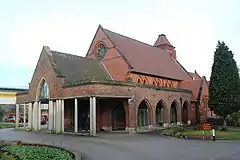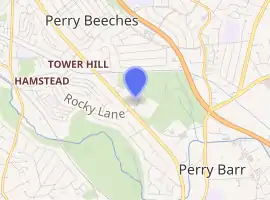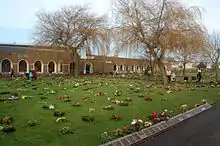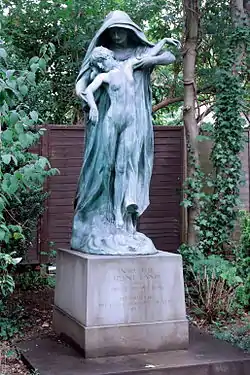Birmingham Crematorium
Birmingham Crematorium is a Protestant crematorium in the Perry Barr district of Birmingham, England, designed by Frank Osborne and opened in 1903. A columbarium was added in 1928. The crematorium is now owned and operated by Dignity plc.
| Birmingham Crematorium | |
|---|---|
 The main building in December 2013 | |

| |
| Alternative names | Perry Barr Crematorium |
| General information | |
| Type | Crematorium |
| Address | Walsall Road, Perry Barr |
| Town or city | Birmingham |
| Country | England |
| Coordinates | 52.52975°N 1.90880°W |
| Opened | 1903 |
| Cost | £7,000 |
| Owner | Dignity plc |
| Design and construction | |
| Architect | Frank Osborne |
Opening
Cremation was not declared legal in Great Britain until 1885, by precedent from the trial of William Price.[1] Despite the opening of Woking Crematorium in 1878[1] and the passing of the Cremation Act 1902, which came into effect on 1 April 1903,[2] it remained controversial, on religious grounds,[3] in the first decade of the twentieth century.[3] However, proposals to build a crematorium for the city of Birmingham, the ninth such facility in the United Kingdom,[4] received support from Sir Oliver Lodge, Principal of the University of Birmingham, and were given the approval of the three local bishops: Edmund Knox (Coventry), Augustus Legge (Lichfield) and Charles Gore (Worcester)[1] (Birmingham did not have its own bishop until 1905).[5]
In a letter read at the opening ceremony, Bishop Gore wrote:[3]
What I should desire when I myself die is that my body should be reduced rapidly to ashes, so that it may do no harm to the living, and then in accordance with Christian feeling be laid in the earth.
Similarly, Bishop Knox wrote that:[3]
In spite of strong sentimental objections very naturally entertained, we shall come to see that under the conditions of modern life cremation is not only preferable from the sanitary point of view, but that it is also the most reverent and decent treatment of the bodies of the dead.
The ceremony was conducted by Sir Henry Thompson, first president of the Cremation Society of Great Britain. His address, wrote The Lancet:[3]
dealt with the history of the cremation movement from its origin in 1874. He referred to the passing of the general Act last session and to the certain increase of cremation in the future. The proceedings at the opening of the Birmingham Crematorium should go far to impress the minds of any who study them with a sense of the desirability of cremation whether viewed from a religious or from a scientific and sanitary standpoint.
It was his last public duty as the society's president; he died the following year, and was cremated at Golders Green Crematorium.[1]
Built on a site previously known as Sheldon Coppice,[6] alongside the A34 (Walsall Road), the Birmingham facility cost £7,000,[4] and had furnaces designed by Messrs. Wilcox & Raikes.[7] The architect was Frank Osborne.[8][9]

A columbarium, detached from the main building, was completed in January 1928.[10]
Current use
The gardens host a Commonwealth War Graves Commission memorial commemorating three World War I and 64 World War II servicemen who were cremated at Perry Barr. Headstones mark the sites of the ashes of one of the 64, and a Czech soldier.[11]
By the time of the centenary commemorations in October 2003, 136,000 funerals had been held.[12]
The crematorium is now operated by Dignity plc and is still in active use.[13] It can accommodate coffins up to 30 inches (76 cm) wide, 1 inch (2.5 cm) less than other crematoria in the vicinity.[14]
Notable cremations
A number of notable people have been cremated at Perry Barr. They include:
- January 1943: Sir Henry Maybury, civil engineer.[15]
- 29 September 1950: John Beard, former leader of the Workers' Union (ashes scattered at Rowton, Shropshire).[16]
- 14 October 2002: Victor Turton, former Lord Mayor of Birmingham.[17]
References
- "Cremation Society of G.B. – History of the Society". Cremation Society of Great Britain. 1 January 1999. Archived from the original on 3 August 2010. Retrieved 21 December 2013.
- The Public General Acts Passed in the Second Year of the Reign of His Majesty King Edward the Seventh. His Majesty's Stationery Office. 1902.
- "Birmingham Crematorium". The Lancet. 162 (4181): 1109. 17 October 1903. doi:10.1016/S0140-6736(01)46268-4.
- "Birmingham Crematorium commemorates 110th anniversary". Dignity plc. Retrieved 21 December 2013.
- "A Brief History of the Diocese of Birmingham". Diocese of Birmingham. Retrieved 22 June 2009.
- Ballard, Phillada (2009). Birmingham's Victorian and Edwardian Architects. Oblong Creative for the Birmingham and West Midlands Group of the Victorian Society.
- Middleton, G. A. T. (1921). Modern Buildings, Their Planning, Construction And Equipment. 5. The Caxton Publishing Company.
- The cemetery handbook: a manual of useful information on cemetery development & management. Allied Arts Publishing Co.
- Haight, R.J. (1906). Park and Cemetery and Landscape Gardening.
- "Local Authorities And Cremation". The Times (44986). 31 August 1928. p. 9 col E.
- "Birmingham (Perry Bar[sic]) Crematorium". Commonwealth War Graves Commission. Retrieved 21 December 2013.
- "Centenary". Birmingham Evening Mail. 8 October 2003. Archived from the original on 10 June 2014. Retrieved 22 December 2013 – via HighBeam Research.
- "Dignity Crematoria and Cemeteries – Crematoria – Find a crematorium". Dignity plc. Retrieved 21 December 2013.
- Randhawa, Kiran (11 January 2003). "Mother 'too big' to be cremated". Birmingham Post. Archived from the original on 10 June 2014. Retrieved 22 December 2013 – via HighBeam Research.
- "Salopian's Notable Career – The Late Sir Henry Maybury, Military and Civil Road Chief". Shrewsbury Chronicle. 18 January 1943. p. 3.Obituary.
- "Sudden Death of Mr J. Beard". Shrewsbury Chronicle. 29 September 1950. p. 4.
- "Reunited: Former Lord Mayors in Tribute to Former Colleague". Birmingham Post. 15 October 2002. Retrieved 22 December 2013.
